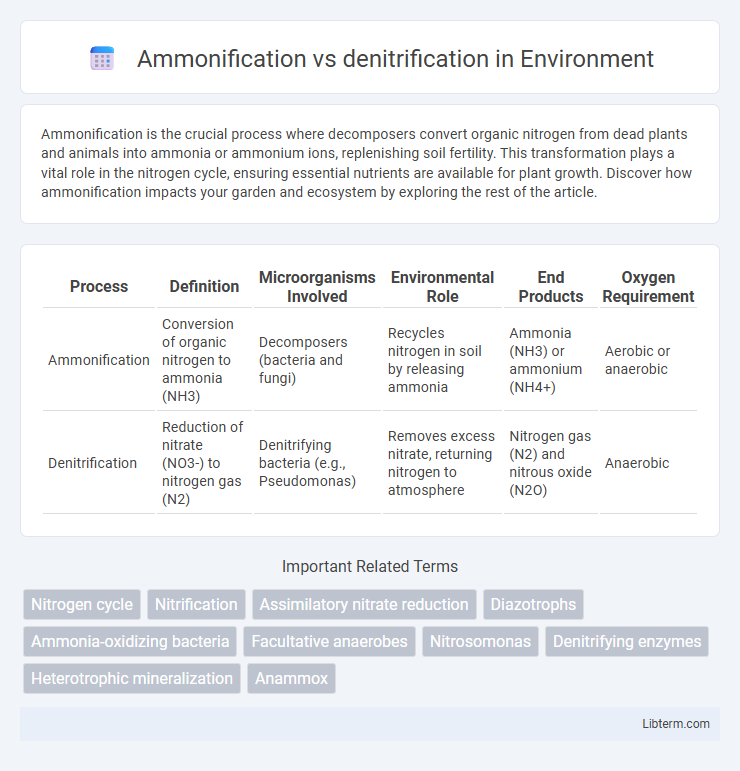Ammonification is the crucial process where decomposers convert organic nitrogen from dead plants and animals into ammonia or ammonium ions, replenishing soil fertility. This transformation plays a vital role in the nitrogen cycle, ensuring essential nutrients are available for plant growth. Discover how ammonification impacts your garden and ecosystem by exploring the rest of the article.
Table of Comparison
| Process | Definition | Microorganisms Involved | Environmental Role | End Products | Oxygen Requirement |
|---|---|---|---|---|---|
| Ammonification | Conversion of organic nitrogen to ammonia (NH3) | Decomposers (bacteria and fungi) | Recycles nitrogen in soil by releasing ammonia | Ammonia (NH3) or ammonium (NH4+) | Aerobic or anaerobic |
| Denitrification | Reduction of nitrate (NO3-) to nitrogen gas (N2) | Denitrifying bacteria (e.g., Pseudomonas) | Removes excess nitrate, returning nitrogen to atmosphere | Nitrogen gas (N2) and nitrous oxide (N2O) | Anaerobic |
Introduction to Nitrogen Cycle
Ammonification and denitrification are key processes in the nitrogen cycle that convert nitrogenous compounds into different forms. Ammonification involves the decomposition of organic nitrogen from dead organisms and waste into ammonia, making nitrogen available to plants and microbes. Denitrification is a microbial process that reduces nitrates to nitrogen gas, returning it to the atmosphere and completing the nitrogen cycle.
What is Ammonification?
Ammonification is the microbial process that converts organic nitrogen from dead plants and animals into ammonia or ammonium ions, making nitrogen available in a form usable by plants. This process is predominantly carried out by decomposer bacteria and fungi in soil ecosystems, playing a critical role in the nitrogen cycle. Ammonification differs from denitrification, which converts nitrates into nitrogen gas, thereby removing bioavailable nitrogen from the soil.
What is Denitrification?
Denitrification is a microbial process that converts nitrate (NO3-) into nitrogen gas (N2), effectively removing bioavailable nitrogen from the soil and releasing it into the atmosphere. This process is primarily carried out by facultative anaerobic bacteria under oxygen-limited conditions, playing a crucial role in the nitrogen cycle by reducing soil nitrate levels and mitigating nitrogen pollution. Denitrification contrasts with ammonification, where organic nitrogen is mineralized into ammonia (NH3), serving as a step in nitrogen recycling rather than nitrogen loss.
Key Microorganisms Involved
Ammonification primarily involves decomposer bacteria such as Bacillus, Clostridium, and Pseudomonas species that break down organic nitrogen compounds into ammonia. Denitrification is carried out mainly by facultative anaerobic bacteria like Pseudomonas, Paracoccus, and Bacillus under oxygen-limited conditions, reducing nitrates to nitrogen gas. These microorganisms play critical roles in the nitrogen cycle by converting nitrogen into bioavailable or gaseous forms.
Ammonification: Process Overview
Ammonification is a crucial step in the nitrogen cycle where microorganisms decompose organic nitrogen from dead plants and animals into ammonia (NH3). This biochemical process is primarily conducted by bacteria and fungi that break down proteins and nucleic acids, releasing ammonium ions (NH4+) into the soil. Ammonification facilitates nutrient recycling by converting organic nitrogen into inorganic forms accessible for plant uptake or further transformation through nitrification and denitrification.
Denitrification: Process Overview
Denitrification is a microbial process that converts nitrate (NO3-) into nitrogen gas (N2), thereby removing bioavailable nitrogen from soil and water ecosystems. This process occurs under anaerobic conditions, primarily facilitated by bacteria such as Pseudomonas and Paracoccus species, which use nitrate as an alternative electron acceptor during respiration. Denitrification plays a crucial role in the nitrogen cycle by reducing nitrogen pollution and mitigating eutrophication in aquatic environments.
Chemical Reactions and Byproducts
Ammonification involves the microbial breakdown of organic nitrogen compounds into ammonia (NH3) or ammonium ions (NH4+), which are essential for plant nitrogen uptake, through hydrolysis and deamination reactions. Denitrification is a microbial process that reduces nitrate (NO3-) to gaseous nitrogen species such as nitric oxide (NO), nitrous oxide (N2O), and nitrogen gas (N2), typically occurring in anaerobic conditions and serving to remove bioavailable nitrogen from soil and water systems. The primary byproducts of ammonification are ammonia or ammonium, which increase soil nitrogen availability, while denitrification produces nitrogen gases that act as atmospheric nitrogen sources but contribute to nitrogen loss from ecosystems.
Environmental Impact of Ammonification and Denitrification
Ammonification releases ammonia into the soil, which can lead to increased nitrogen availability for plants but also contributes to soil and water pollution if excessive, causing eutrophication and toxicity to aquatic life. Denitrification reduces nitrates to nitrogen gas, decreasing soil fertility but mitigating nitrate accumulation and preventing groundwater contamination, thus playing a crucial role in reducing greenhouse gas emissions like nitrous oxide. Both processes significantly influence nitrogen cycling and environmental health by balancing nutrient availability and minimizing pollution risks.
Comparative Table: Ammonification vs Denitrification
Ammonification converts organic nitrogen into ammonium (NH4+), primarily by decomposers breaking down proteins and nucleic acids in soil and water. Denitrification transforms nitrate (NO3-) into nitrogen gas (N2) or nitrous oxide (N2O), conducted by anaerobic bacteria under low-oxygen conditions, returning nitrogen to the atmosphere. Key differences include ammonification's role in nitrogen recycling for plant uptake versus denitrification's function in nitrogen loss from ecosystems, influencing soil fertility and nitrogen availability.
Importance in Agriculture and Ecosystem Health
Ammonification converts organic nitrogen from dead plants and animals into ammonium, replenishing soil nitrogen essential for crop growth and maintaining soil fertility. Denitrification reduces soil nitrate to nitrogen gas, preventing nitrate accumulation that can cause water pollution and gas emissions, thus balancing nitrogen levels in ecosystems. Both processes are vital for sustainable agriculture and ecosystem health by regulating nitrogen cycling and minimizing environmental impacts.
Ammonification Infographic

 libterm.com
libterm.com